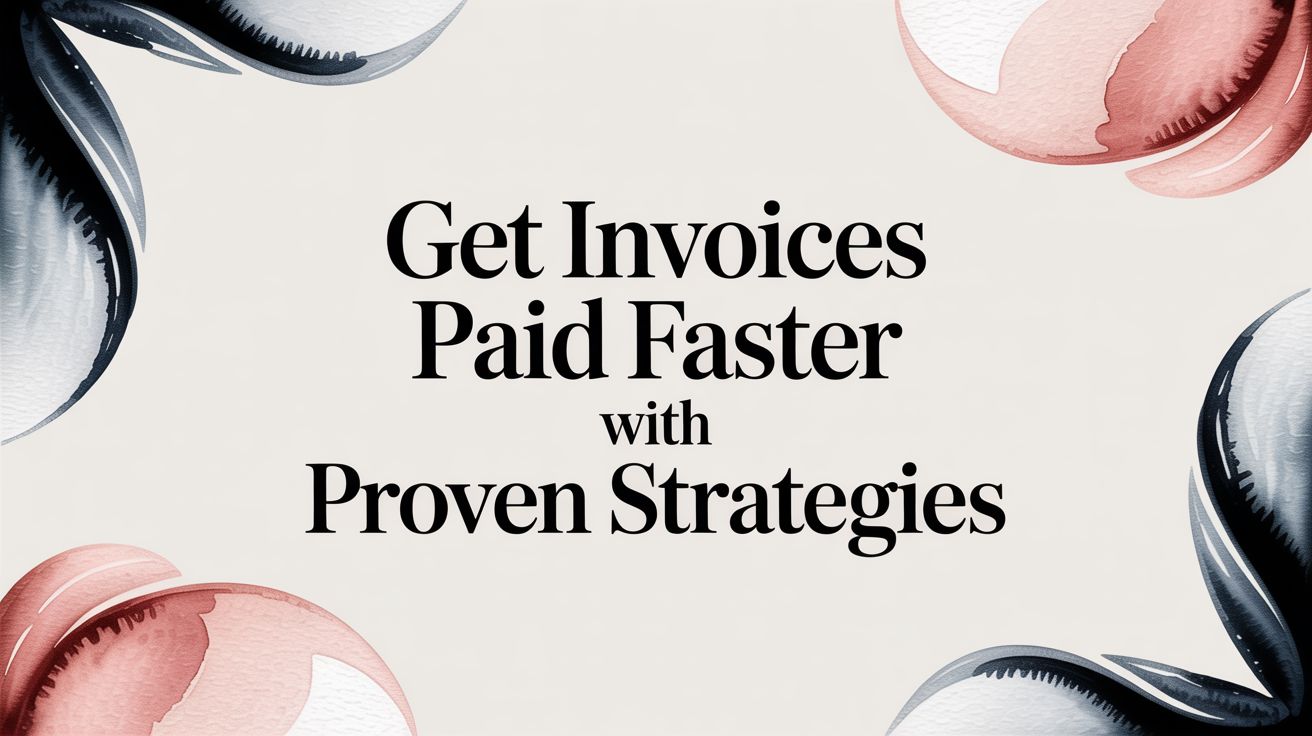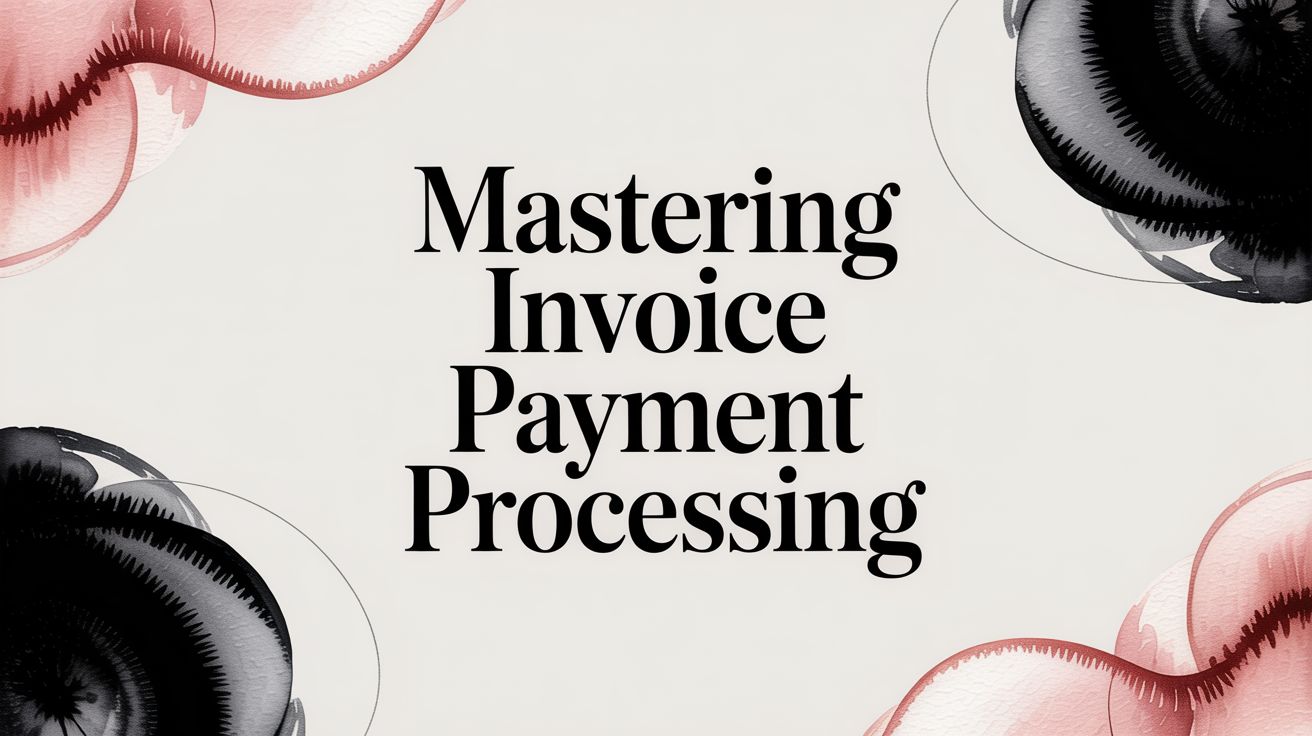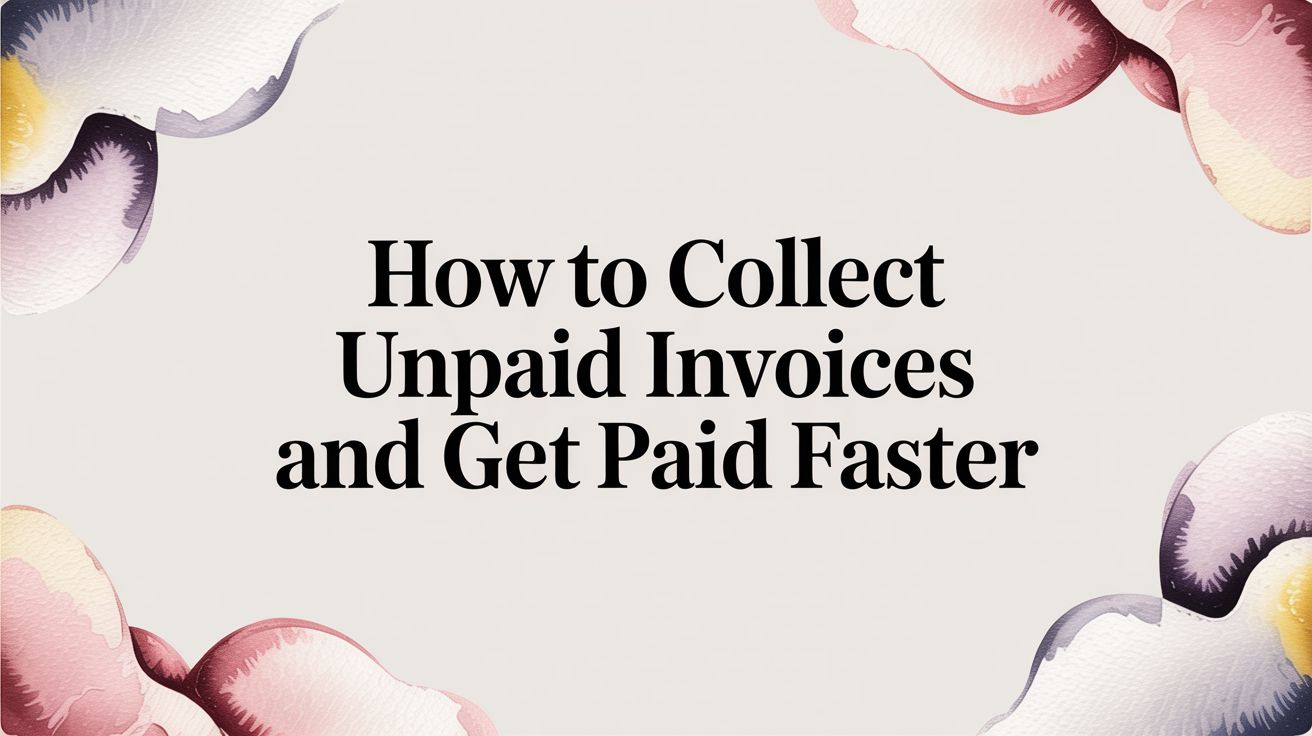Getting paid on time isn’t about chasing money you’re already owed. That’s a reactive game, and it’s one you’ll always be playing from behind. The real win is shifting your mindset to be proactive—building a system where quick, hassle-free payments are simply the way you do business.
It all boils down to creating crystal-clear invoices, offering effortlessly simple payment options, and setting up an automated follow-up process. This isn’t about hounding clients; it’s about making it so easy for them to pay you that they just do.
The True Cost of Chasing Late Payments

Let’s be honest, late payments are more than just an annoyance on your balance sheet. They’re a silent thief, stealing your time, your energy, and your business’s momentum.
Every single hour you spend sending another “gentle reminder” is an hour you can’t get back. That’s time you could have spent brainstorming your next big idea, delighting another client, or even just taking a well-deserved break. It’s an invisible tax on your ambition, and it’s holding you back.
The stress is real, too. Watching your bank account shrink while you wait on money you’ve already earned is a heavy weight to carry. It injects a constant, low-level anxiety into your work, making it incredibly difficult to think creatively or make bold, forward-thinking decisions.
Beyond the Balance Sheet
The damage goes much deeper than just the numbers. An unpredictable cash flow can bring your growth to a screeching halt, forcing you to miss out on game-changing moments.
- Missed Growth Opportunities: Ever had to pass on a huge project because you couldn’t front the initial costs? It’s a gut-wrenching feeling.
- Stalled Investments: That new piece of equipment, essential software subscription, or much-needed hire stays on the wish list, keeping you from leveling up.
- Damaged Client Relationships: Nobody enjoys being the bill collector. Constantly chasing payments injects an awkward tension into what should be a positive, professional partnership.
This isn’t a problem unique to you; it’s a global issue that hits small businesses the hardest. In the UK alone, a staggering 62% of small businesses are stuck dealing with overdue invoices. It’s so severe that it forces around 50,000 businesses to close their doors each year. Learning how to get invoices paid faster isn’t just a “best practice”—it’s a critical survival skill. If you want to dive deeper, you can explore more late payment statistics to see the full picture.
Waiting for payments is like trying to run a marathon with your shoelaces tied together. You’re working twice as hard just to stay in the race, let alone win it.
This guide is your playbook for untying those knots once and for all.
Craft an Invoice That Demands Attention
Think of your invoice not just as a bill, but as the final, professional handshake after a job well done. If it’s confusing, vague, or unprofessional, it’s all too easy for a busy client to set it aside and forget about it. To get paid faster, your invoice needs to be crystal clear and incredibly simple for them to act on.
Let’s be real: your client is juggling a dozen other things. Your invoice has to cut through that noise instantly. This starts with clean, professional branding—your logo and company details should be front and center, reinforcing who you are and making life easier for their accounts payable team.
Then, get specific. Vague descriptions like “Consulting Services” are a recipe for questions and delays. Instead, break it down with precise line items like “Q2 Social Media Strategy & Content Calendar (20 hours)” or “Complete Redesign of Website Homepage UX.” Every single item needs a clear cost, all leading to an unmistakable grand total. No guesswork allowed.
Make Payment Effortless
The biggest roadblock to getting paid on time? Friction. If a client has to dust off a checkbook or log into a clunky, unfamiliar portal to pay you, you’ve already created a reason for them to procrastinate.
This is where a modern, well-designed invoice makes all the difference. It’s built from the ground up to remove those annoying barriers and speed up your cash flow.
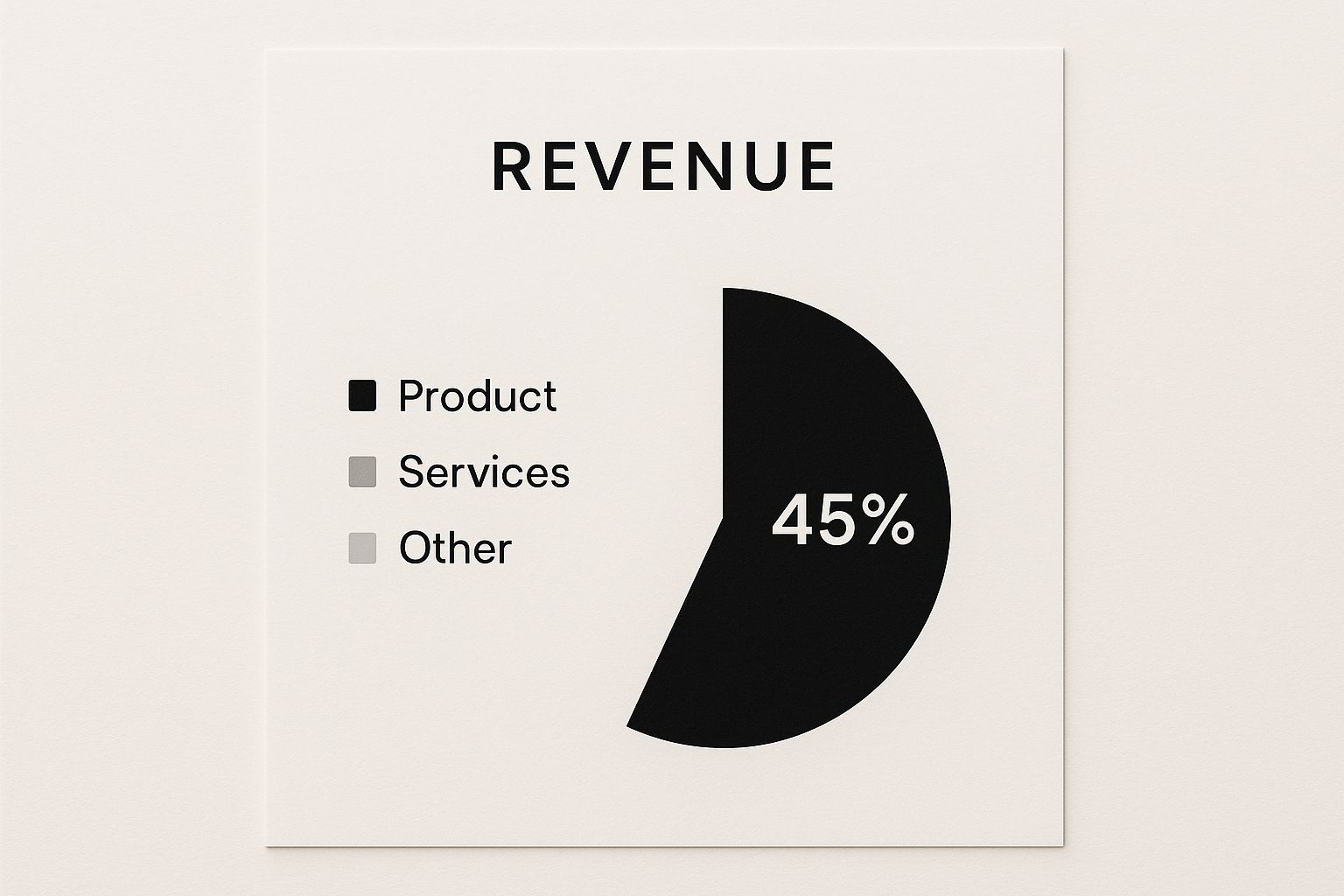
As you can see, the key is integrating multiple payment options right on the invoice itself. When they can click a button to pay with a credit card or a digital wallet, you’ve turned a chore into a simple, one-click action.
Clarity is just as crucial when it comes to your payment terms. Ditch the old-school jargon like “Net 30.” Be direct and state the exact due date in a bold, can’t-miss spot. Something like “Payment Due: October 26, 2024” removes every ounce of ambiguity.
A great invoice answers every question before it’s asked. It confirms what was delivered, what it cost, when it’s due, and how to pay—all in a single glance.
Finally, make sure your full terms and conditions are easy to find. Including a link to your payment policies builds trust and gives you something to stand on if issues arise. You can see how we transparently outline expectations in our own terms and conditions. When you’re this proactive and professional from the start, you create a smooth path to getting paid faster and more reliably.
Put Your Collections on Autopilot
Let’s be honest. Chasing down late payments is one of the most draining parts of running a business. Every minute you spend writing a “just following up” email is a minute you could have spent on strategy, innovation, or simply enjoying your work. It’s time to stop the manual grind and put your collections process on autopilot.
Imagine this: you set up a smart, professional follow-up sequence just once, and it runs itself forever. This isn’t about becoming a robot; it’s about creating a consistent, reliable system. Automation ensures every single client gets a polite heads-up before an invoice is due and a series of professional reminders after, all without you having to think about it.
This is your secret weapon against simple human error. No more invoices slipping through the cracks. Every message is perfectly timed and worded, which keeps your client relationships strong while making your payment expectations crystal clear.
Why Automation Is a Game-Changer
Moving to automation isn’t just about convenience—it’s a massive strategic advantage. You might be surprised to learn that many payment delays have nothing to do with your client’s willingness to pay. Instead, they’re often bogged down by their own slow, manual processes. Think about it: a shocking 49% of companies spend over five days every month just manually processing invoices.
When you send an automated, professional reminder, you make it incredibly easy for their systems (and their people) to prioritize paying you. This is why 20% of teams are already fully automated, with another 41% planning to jump on board in the next year.
Before we dive into how you can set this up, let’s look at a quick comparison that really highlights the difference.
Manual Invoicing vs Automated Invoicing
| Feature | Manual Invoicing | Automated Invoicing (with JustPayUp) |
|---|---|---|
| Time Spent | Hours of chasing per week | Minutes to set up, then runs itself |
| Error Rate | High risk of typos, missed follow-ups | Virtually zero errors |
| Payment Speed | Often delayed due to inconsistent follow-ups | Significantly faster, often paid before due date |
| Professionalism | Can feel inconsistent or emotionally driven | Always professional, polite, and on-brand |
| Client Experience | Can be frustrating for clients receiving sporadic reminders | Smooth and predictable, with easy payment links |
The difference is night and day. Automation isn’t just about saving time; it’s about creating a better, more professional experience for everyone involved.
Automation is the ultimate act of professional self-care. It frees you from the administrative burden of chasing payments, allowing you to focus on the work that truly matters.
Designing Your Automated Follow-Up Cadence
A great automation tool, like JustPayUp, lets you build a sequence of reminders that feel personal but work tirelessly in the background. The goal is to be persistent without ever coming across as pushy.
Here’s a simple but incredibly effective workflow I’ve seen work wonders:
- The Gentle Nudge (3 days before due): Send a friendly heads-up that an invoice is due soon. This one email prevents so many late payments before they even happen.
- The Due Date Alert (On the due date): A clear, professional notification that payment is now due. Make sure to include a big, obvious link to pay online.
- The First Reminder (3 days past due): This is the first official overdue notice. Keep it polite but firm. It’s also a great opportunity to be helpful by linking to resources, like what to do if you see a failed payment notification.
- The Second Reminder (7 days past due): Time to be a bit more direct. This follow-up should clearly state the overdue status and prompt immediate action.
By putting a system like this in place, you’re not just a freelancer or a small business owner anymore—you’re a professional with a clear, unshakable process. You’ll be amazed at how much faster you get invoices paid.
Master the Follow-Up Conversation
Let’s be honest, chasing down an overdue invoice can feel… awkward. But mastering the follow-up is a skill that separates the pros from the amateurs. It’s a delicate dance between professional persistence and genuine grace.
Your goal isn’t to become a hard-nosed bill collector. Think of yourself as a proactive partner, simply keeping the lines of communication open. How you say something, and when you say it, makes all the difference.
Always start with the assumption that your client is busy and simply forgot. We’ve all been there. A gentle, automated reminder a few days after the due date is often all it takes to jog their memory. The key here is to keep the initial message light, helpful, and completely free of any accusatory language.
If that first friendly nudge doesn’t get a response, it’s time to become a little more direct, but you still want to keep the relationship positive. Following up a week later lets you restate the invoice details and politely ask if there’s a problem holding up the payment. This simple act shows you’re organized and serious about your payment terms without burning any bridges.
Structuring Your Follow-Up Messages
Your communication has to evolve as an invoice gets further past its due date. Each message should have a crystal-clear purpose, whether it’s a soft reminder or a more firm and final notice.
Here’s a simple rhythm I’ve found works wonders:
- The Friendly Nudge (3-5 Days Overdue): Keep it short and sweet, and assume they just missed it. A quick, “Just wanted to gently check in on invoice #123,” is perfect.
- The Gentle Reminder (7-10 Days Overdue): Now’s the time to re-attach the invoice and ask for an update. Something like, “Could you please let me know when we can expect payment for the attached invoice?” works well.
- The Firm Notice (15+ Days Overdue): The tone shifts here from a question to a direct statement. You might say, “Invoice #123 is now 15 days past due. Please remit payment immediately to avoid any potential service interruptions.”
The best follow-up conversations feel like a collaboration, not a confrontation. You’re simply working together to close an open loop. This preserves the client relationship and, most importantly, helps you get paid.
Knowing When to Pick Up the Phone
If you’ve sent two or three emails into the void with no reply, it’s time to pick up the phone. An email is incredibly easy to ignore or “lose” in a crowded inbox. A real conversation? Not so much.
Before you dial, get your talking points straight. Stay calm, be professional, and focus on finding a solution.
A simple script like, “Hi [Client Name], I’m calling about invoice #123. I just wanted to make sure you received it and see if there’s anything on your end holding up the payment,” can instantly cut through the silence and get you the answers you need.
Make It Ridiculously Easy for Clients to Pay You
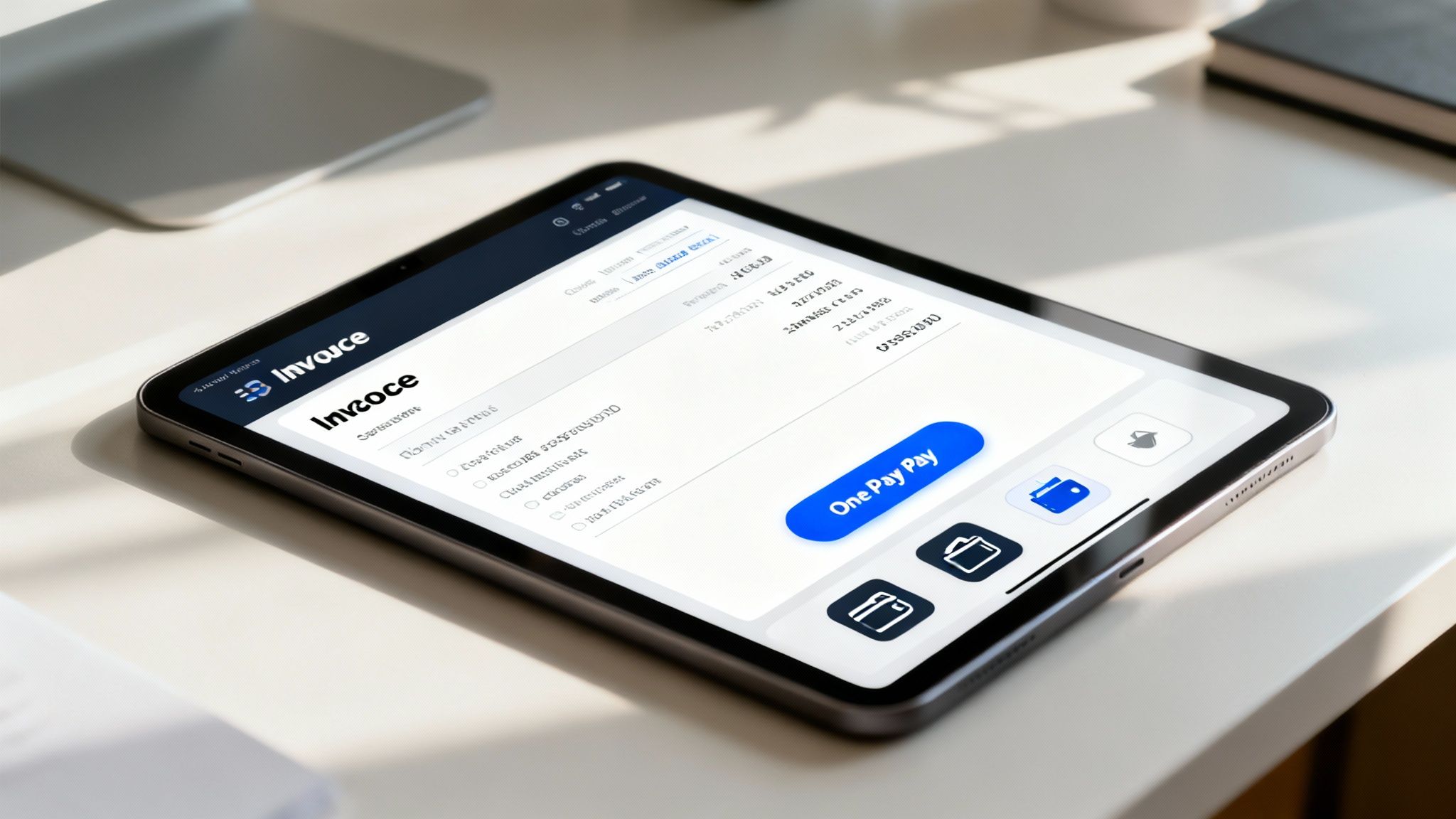
Let’s be honest. The biggest reason invoices get paid late is simple friction. If paying you means your client has to hunt down a checkbook, log into a clunky payment portal, or fill out a form from 1998, your invoice is going straight to the bottom of their to-do list.
To really speed things up, you have to make the payment process so seamless it’s almost an impulse. It’s time to move past old-school bank transfers and start accepting payments the way your clients actually prefer to pay for everything else in their lives.
Think about the difference. When a client can open your invoice email and pay you with a single click—using their credit card or a digital wallet they already have saved—you’ve turned a dreaded chore into a satisfying, two-second task. This isn’t just an expense; it’s one of the smartest investments you can make in your cash flow.
Give Them the Payment Options They Expect
In today’s world, offering modern payment methods isn’t just a nice-to-have, it’s a core business function. Instant payments are quickly becoming the standard, and clients are starting to expect that same convenience from everyone they do business with, including you.
The data backs this up. By 2025, more than 30% of financial professionals are already seeing a positive impact from faster payment systems, and 28% are specifically pointing to benefits in B2B transactions. You can explore more of these payment industry statistics for 2025 to see just how fast things are changing.
When you make paying you as easy as buying a book on Amazon, you systematically remove every single excuse for a delay. The goal is zero friction, from the moment they open the email to the second they see that “thank you” page.
This isn’t just about getting your money faster, either. It’s about elevating the entire client experience. A smooth, simple transaction is the final, positive touchpoint of a great project. Sending an immediate and clear payment confirmation wraps everything up professionally, making your client feel confident and satisfied with their decision to work with you.
Your Burning Questions About Getting Paid, Answered
Even with a rock-solid plan, you’re bound to have questions. We all do. Let’s dig into a couple of the most common ones I hear from freelancers and business owners. Getting these right can be a game-changer for your cash flow.
When Is the Absolute Best Time to Send an Invoice?
Simple: send it the moment your work is done and delivered. Don’t wait. The value you’ve just created is top-of-mind for your client, and that sense of satisfaction often translates into a quick payment.
A little pro-tip from experience? Avoid sending it late on a Friday afternoon. It’ll just get lost in the weekend shuffle. Aim for a Monday or Tuesday morning instead—that’s when people are in “get things done” mode.
How Do I Deal With a Client Who Always Pays Late?
Ah, the chronic late-payer. It’s a frustrating but common problem. The key here is to be proactive, not reactive.
Before you even start their next project, have an open conversation about payment expectations. This is the perfect time to introduce new terms that protect you.
- Consider asking for a 50% upfront deposit.
- Move them to a shorter payment window, like Net 15 instead of Net 30.
- Make sure your late fee policy is impossible to miss in your contract and on the invoice itself.
Late fees aren’t about punishing your clients; they’re about reinforcing your professionalism. They set a clear boundary and show that you treat your deadlines—and your business—seriously.
Implementing a small, automatic late fee, usually 1-2% per month, is a surprisingly effective nudge. It’s not a huge amount, but it’s often just enough to move your invoice to the top of their to-do list.
Ready to stop chasing and start getting paid on time, every time? JustPayUp puts your collections on autopilot so you can focus on what you do best. Explore JustPayUp and see how it works.


